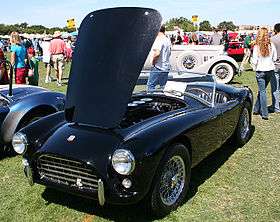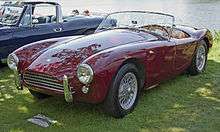AC Ace
| AC Ace | |
|---|---|
 1953-1963 AC Ace | |
| Overview | |
| Manufacturer | AC Cars |
| Production | 1953–1963 [1] |
| Body and chassis | |
| Class | Roadster |
| Body style | 2-door roadster |
| Related |
AC Aceca AC Greyhound AC Cobra |
| Powertrain | |
| Engine |
2.0 L I6 (AC) 2.0 L I6 (Bristol) 2.6 L I6 (Ford) |
| Transmission | 4-speed manual (With overdrive available) |
| Dimensions | |
| Wheelbase | 90 in (2,286 mm) [2] |
| Length | 152 in (3,861 mm)[2] |
| Width | 59.5 in (1,511 mm) [2] |
| Height | 49 in (1,245 mm) [2] |
| Curb weight | 1920 lb (871 kg) |
| Chronology | |
| Successor | AC Cobra |
AC Ace is a car which was produced by AC Cars of Thames Ditton, England, from 1953 to 1963.
History
AC came back to the market after the Second World War with the staid 2-Litre range of cars in 1947, but it was with the Ace sports car of 1953 that the company really made its reputation in the post war years. Casting around for a replacement for the ageing 2-Litre, AC took up a design by John Tojeiro[2] that used a light ladder type tubular frame, all independent transverse leaf spring suspension, and an open two seater alloy body made using English wheeling machines, possibly inspired by the Ferrari Barchetta of the day.
Early cars used AC's elderly 100 bhp (75 kW) two-litre overhead cam straight-six engine (first seen soon after the end of the First World War), which, according to a 1954 road test by Motor magazine, gave a top speed of 103 mph (166 km/h) and 0–60 mph (0–100 km/h) in 11.4 seconds and a fuel consumption of 25.2 miles per imperial gallon (11.2 L/100 km; 21.0 mpg-US).[2] It was hardly a sporting engine, however, and it was felt that something more modern and powerful was required to put the modern chassis to good use.
Joining the Ace in 1954 was the Aceca hard top coupé, which had an early form of hatchback rear door but used the same basic timber framed alloy body.
From 1956, there was the option of Bristol Cars' two-litre 120 bhp (89 kW) straight-six with 3 downdraught carburettors and slick four-speed gearbox. Top speed leapt to 116 mph (187 km/h) with 0–60 mph (0–100 km/h) in the nine second bracket. Overdrive was available from 1956 and front disc brakes were an option from 1957, although they were later standardised.

In 1961 a new 2.6-litre (2,553 cc (155.8 cu in)) straight-six 'Ruddspeed' option was available, adapted by Ken Rudd from the unit used in the Ford Zephyr. It used three Weber or SU carburettors and either a 'Mays' or an iron cast head. This setup boosted the car's performance further, with some versions tuned to 170 bhp (127 kW), providing a top speed of 130 mph (209 km/h) and 0–60 mph (0–100 km/h) in 8.1 seconds.[3] However, it was not long before Carroll Shelby drew AC's attention to the Cobra, so only 37 of the 2.6 models were made.[4] These Ford engined models had a smaller grille which was carried over to the Cobra.
With the engine set well back in the chassis, the Ace handled well and was successful in competition.
Motor Sport
The car raced at Le Mans in 1957 and 1958. In 1959 at Le Mans, Ted Whiteaway and John Turner drove their AC-Bristol, registration 650BPK, to the finish, claiming top honours for the 2,000cc class and seventh overall behind six 3 litre cars. Few cars with this provenance have survived and are extremely valuable. They can range from $100,000 or more for an unrestored car, even one in pieces, to in excess of $400,000 for a restored AC Ace.
AC Cobra
When Bristol ceased building their 6-cylinder engine in 1961, AC's owner, Charles Hurlock, was approached by Carroll Shelby to use a Ford V8 in the Ace chassis, producing the AC Cobra in 1962. Production of the Ace ended the same year. The AC Cobra came in small block and later big block configurations. It was Ford's 289 that powered the winning car in the GT class at Le Mans in June 1964. At the time, the AC Cobra 427 was the fastest "production" car in the world.
AC Automotive
AC Automotive, based in Straubenhardt, Germany still builds the AC under the original name. Cars are sold in Germany, France and England with sales in Luxembourg, Holland, Lichtenstein, Switzerland and Belgium slated for the future. Pricing for the standard ACGT model starts at £104,400 before options.
Replicas
As with the Cobra, some AC Ace replicas have been made such as the Hawk Ace but are much rarer.
External reference
| Wikimedia Commons has media related to AC Ace. |
References
| AC Cars road vehicle timeline, 1950–1984 | |||||||||||||||||||||||||||||||||||
|---|---|---|---|---|---|---|---|---|---|---|---|---|---|---|---|---|---|---|---|---|---|---|---|---|---|---|---|---|---|---|---|---|---|---|---|
| Type | 1950s | 1960s | 1970s | 1980s | |||||||||||||||||||||||||||||||
| 0 | 1 | 2 | 3 | 4 | 5 | 6 | 7 | 8 | 9 | 0 | 1 | 2 | 3 | 4 | 5 | 6 | 7 | 8 | 9 | 0 | 1 | 2 | 3 | 4 | 5 | 6 | 7 | 8 | 9 | 0 | 1 | 2 | 3 | 4 | |
| Microcar | Petite | Petite | |||||||||||||||||||||||||||||||||
| Sports car | Ace | ||||||||||||||||||||||||||||||||||
| Cobra | Cobra | Cobra | 3000ME | ||||||||||||||||||||||||||||||||
| Executive car | 2-Litre | Greyhound | |||||||||||||||||||||||||||||||||
| Grand tourer | Aceca | Frua | |||||||||||||||||||||||||||||||||